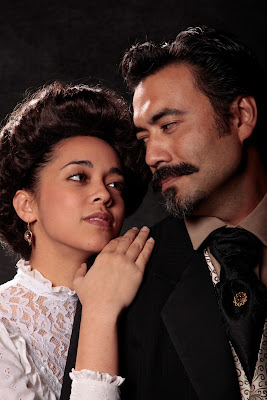Creative History, Complex Characters — WILCOX'S SHOT at KKT
With a more-than-capable cast, O’Malley’s Shot hits the mark
 |
| Theresa & Robert |
You don’t have to know the history to understand the issues
brought forth in Wilcox’s Shot—just pay attention. O’Malley places his
protagonist in the political stew of 1901 America, exposing the complexities of
race, place, and gender relations.
Historical fact pulled from newspaper articles and other
reliable sources, music and performance art of the period, and the suppositions
of a talented imagination combine through a series of realistic and stylized
scenes into a compelling drama. O’Malley’s dramaturgical prowess provides
Director Brett T. Botbyl with a number of challenging opportunities.
The early scenes develop the playfully intimate relationship
between Wilcox and his wife, Princess Theresa Owana Ka‘oheleani La‘anui Wilcox,
played by Danielle Zalopany, whose expressions throughout manage to convey
quite a few unwritten words. This princess is beautiful and independent minded—a
force to be reckoned with.
Albert Ueligitone stars as Wilcox, bringing to life a fully
realized character, with genuine emotion, charisma, and charm (and a really
good mustache). A younger Ueligitone portrayed a younger Wilcox in O’Malley’s
second play featuring the character, Island Skin Songs, when it
premiered at KKT over a decade ago, which may explain why he knows this part
inside and out. The passion of husband and wife—for one another and for their
cause—ignites much of the tension.
The rest comes from the Wilcoxes’ interaction with other
famous historical figures: Theodore and “Edie” Roosevelt; entertainer Bert
Williams; and even anarchist Emma Goldman. Each historical character brings
something important to the story.
O’Malley imagines Theodore and Edie, played by Tony
Nickelsen and Jenn Thomas, as somewhat intimate acquaintances of the Wilcoxes.
Nickelsen’s Roosevelt affects strength greater than he truly possesses and,
though a good person at heart, is ultimately unable to stand up for his beliefs.
Thomas commands—her husband and everyone watching—as the fan-wielding first
wife. Their relationship provides a dramatic counterpoint to the Wilcoxes’.
Rikki Jo Hickey’s Emma Goldman is a chiding yet flirty
“aunty” figure with a sharp Lithuanian tongue: “Don’t be their trained
monkey,” she warns. Her reappearance late in the play has a surreal quality, as
though Wilcox, high on his stomach tonic Peruna, has possibly dreamt her up in
his time of need.
Actors Troy M. Apostol, Scott Robertson, and Jordan T.
Savusa, each with two roles, provide remarkably authentic characters.
Robertson’s Leon Czolgosz is flawlessly extreme. “I am a man of action too,” he
says, in a show-stopping moment. Savusa’s Booker T. Washington exudes
composure.
The relationship between performance and politics is a theme
in Wilcox’s Shot—both politician and performer must play to the
audience. Apostol’s Bert Williams—in a perspicaciously directed scene—makes the
comparison shortly before the stage transitions to an out-of-time spotlight on
the performer presenting the song “Nobody,” which speaks to the callousness of
the era and the sad, solitary state of human existence.
Boxing is also used as a metaphor—sparring and shadow. The
shadowboxing scenes deliver Wilcox’s frustration and are perfectly staged to
complement his ineffectual petitions to congress. The sparring scenes between
Wilcox and Roosevelt, brilliant in theory, fall flat in this staging. The
realistic approach—two gloved men talking at one another with minimal movement—appears
awkward and false.
Botbyl’s vision, as mentioned in his Director’s Note,
of “sepia hues and faded newsprint”
shows in the set, costume, and lighting designs, and the scenes end in a
“freeze frame” evoking old photographs. Unfortunately, many of the scene
changes take as long to manage as those old cameras probably took to change the
film. Done in blackout, much inherent momentum dies in the dark. Lowlight would
have kept the attention while also evoking the theme of history as something literally
reconstructed.
Wilcox’s Shot will fascinate anyone with an interest
in historical drama and the play should in no way be thought of as a nostalgic
period piece. The complex relationship created between Wilcox and Roosevelt
reveals the sticky entanglements of power, action, and popular opinion. The
final scene is a subtle dance, a culmination of ideas on what it means to be a
patriot, a leader, a friend, or maybe just a human being—someone striving to do
something, to be effective, to take a shot.
[Kumu Kahua Theatre, 46 Merchant St., runs through Sun. 4/29, Thu.–Sat. 8pm; Sun., 2pm, $5-$20, [kumukahua.org], 536-4441]
A slightly modified version of this review originally appeared in the 4/18 issue of the Honolulu Weekly.


Comments
Post a Comment